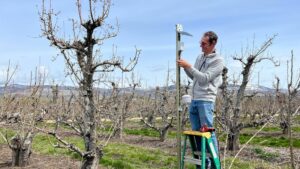How many boxes have you opened in the past week? In the past month? Over the last two years?
According to Digital Commerce 360, online shopping during the pandemic added $218.53 billion to eCommerce’s bottom line since March 2020. And with e-commerce comes boxes. Lots of boxes—sometimes boxes you had no idea you’d ordered. And with boxes come bubble wrap and other non-recyclable materials, headed straight to the landfill.
This year’s Startup Challenge Monterey Bay Venture Division winner Little Feet Packaging has a solution: Pubble. Composed of two layers of recycled paper bound by a compostable and recyclable starch-based adhesive, Pubble is a sustainable solution to cushioning and packing products for shipment.
“Pubble stands for paper bubble,” said Nicholas De Luca, founder of Little Feet Packaging. “What we do is take two layers of 100% recycled paper, put a starch-based adhesive in there, die-cut [the paper] at high speed, and then create a roll which then gets stamped. The stamping process forms the dome shape into the paper, which provides the cushioning for products. It’s very flexible, you can wrap it, and you can tuck it into products as well.
The name “Little Feet Packaging” originated from De Luca’s desire to create a more sustainable future for his children. The company logo features an old Xerox of his daughter’s feet, which are currently dancing in the Sarasota Ballet. His son’s tiny feet grace the homepage of their website.
De Luca came up with the idea for Pubble while weighing the benefits and costs, and aesthetics of current packing materials available on the market.
“Imagine the entire city of San Jose almost covered twice,” he said. “That is how much bubble wrap in the U.S. is made every year. What we’re trying to do is to replace at least a good chunk of that to be used on-site at eCommerce facilities, as well as producing that for retailers or users at home. We really want to try to do what bubble wrap has conventionally done with a paper alternative that’s compostable and recyclable.”
While bubble wrap alternatives currently exist, De Luca decided to maintain the bubble wrap aesthetic.
“The idea originated from thinking about packaging overall— plastic packaging and paper packaging specifically— and the alternatives that are available, he said. “There is craft paper that’s been wadded, which doesn’t have the aesthetic appeal of something like bubble wrap. While we don’t have the pop yet figured out, we do have the beauty that the bubble wrap offers a customer and the same performance in many applications.”
Little Feet Packaging entered Startup Challenge about a year after they began marketing and selling Pubble. De Luca credits the experience with helping the company focus its mission and strategy, particularly with the mentorship aspect of the competition.
“It was a wonderful experience. We’d been involved in the business for about a year in marketing and selling, but it really did help to hone in our own thinking and really critically examine what we were doing from a business perspective,” he said.
Startup Challenge is an annual competitive business accelerator for new businesses that teaches, coaches, mentors, networks, and connects entrepreneurs to the knowledge and resources they need to succeed in the marketplace. The competition is organized by the Institute of Innovation and Economic Development (iiED), an institute of the College of Business at California State University Monterey Bay
According to De Luca, the entire process leading to the Challenge was extremely valuable. “The whole competition was very helpful, whether we had won or not, it was very, very helpful.”
De Luca hopes that Little Feet Packaging products can begin to replace bubble wrap, asserting that even a small percentage takeover could make a huge difference.
“We are hoping to take a big chunk out of the bubble wrap that you find on the shelves and stores, what you’re getting at home. We may not be able to completely take all of that, but if we can start to chisel away, even at one, two, three percent of that entire market, it’s almost a billion dollars a year in the United States.”


